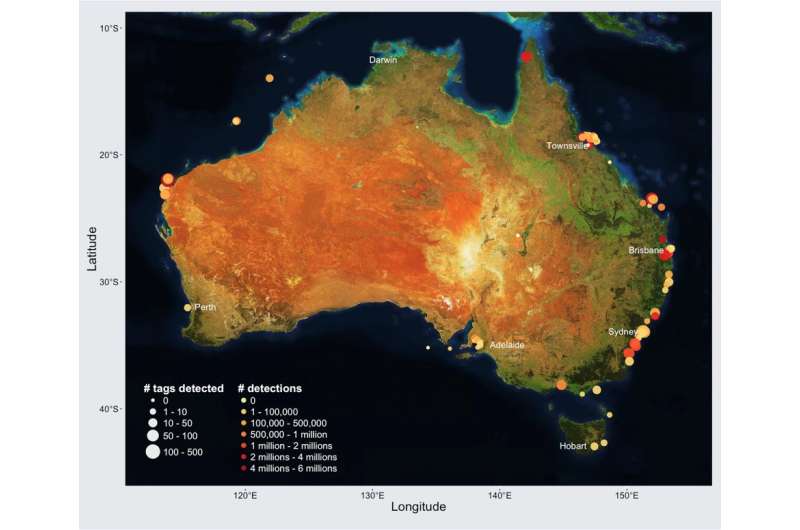New Australian marine tracking system maps a decade of widespread movements of our iconic sea species

A new study led by researchers at the Integrated Marine Observing System (IMOS) and Macquarie University, and published in Scientific Data, has tracked the whereabouts of 117 marine species, ranging from sharks and saltwater crocs all the way to sea turtles and sea cows (dugongs), off the shores of Australia. The data is helping to unravel the widespread movements of Australian marine species, the researchers say, and provide insight into the natural habitats, distributions and changing behaviours of these animals in the face of climate change.
"The established IMOS Animal Tracking Facility network, consisting of nearly 2,000 receiving stations located around the country, allowed us to track 3,777 Australian sea animals, including some of Australia's most iconic species, such as great white sharks, green sea turtles and tunas," explained lead author Dr. Xavier Hoenner from the Integrated Marine Observing System (IMOS).
"We collected and quality controlled 49.6 million acoustic detections from these tagged animals, which has given us insights into how far they moved, ranging from only a few kilometres to thousands, their preferred habitats and how their movements vary over time," added Hoenner.
It has been known for some time that climate change is causing oceans around Australia to be warmer further south, meaning many marine species are also shifting south, altering their habitual movements and feeding habits.
"The data gives an in-depth picture of the behaviour of these animals over the ten years of the study enabling us to predict how behaviour might change in the future. For example, in the case of bull sharks – a species we tracked that is known to be potentially dangerous – research has shown that they move within warmer waters, meaning it is important that we understand how they modify their movements in response to changes in ocean conditions and processes," explained Professor Rob Harcourt from Macquarie University, who is the Leader of the Animal Tracking Facility at IMOS.
The researchers say that the data is a powerful addition to their centralised national database, and hope that the results will also foster future investigations by other marine research groups.
"In this study we were able to validate our tracking data by developing an open-source, state of the art algorithm that identifies background noise signals and anomalous movements, thus strengthening considerably the quality and re-usability of our dataset. The data is available through the online Australian Ocean Data Network Portal, making it a very valuable resource for comparing the behaviour of marine animals today and in the future. We are also going to add the data to public marine species location databases to improve existing biodiversity records and enhance existing geographical distribution maps for Australian sea species," Professor Harcourt concluded.
More information: Xavier Hoenner et al. Australia's continental-scale acoustic tracking database and its automated quality control process, Scientific Data (2018). DOI: 10.1038/sdata.2017.206
Provided by Macquarie University





















